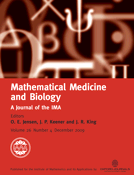-
Views
-
Cite
Cite
Marissa S. Fallon, Brett A. Howell, Anuj Chauhan, Importance of Taylor dispersion in pharmacokinetic and multiple indicator dilution modelling, Mathematical Medicine and Biology: A Journal of the IMA, Volume 26, Issue 4, December 2009, Pages 263–296, https://doi.org/10.1093/imammb/dqp004
Close - Share Icon Share
Abstract
Mass transfer in tissues is typically studied by multiple indicator dilution (MID) studies. Several of these studies have shown that drug concentrations can be modelled by axially distributed models. In this paper, we determine the Taylor dispersion coefficient that describes the degree of axial mixing for the MID models, while accounting for the presence of red blood cells in the capillaries. The capillaries are treated as well mixed with no radial concentration gradients. The concentration in tissue is treated as position and time dependent and the partial differential equations for mass transport are averaged using the method of multiple timescales. The calculated values of the dispersion coefficient are in reasonable agreement with the values reported in literature, suggesting that Taylor dispersion is an important contributor to dispersion in tissues. We also show that the average equations for the barrier-limited drugs reduce to the commonly used Sangren–Sheppard model. In this case, Taylor dispersion is not significant in comparison to the dispersion caused by drug exchange between the capillary and the tissue. Additionally, we utilize the average equations for both flow-limited and barrier-limited drugs in pharmacokinetic models. These simulations show that neglecting the dispersion coefficient could cause significant effects in the dynamic drug concentration profiles and thus lead to incorrect estimation of parameters if the experimental data from MID studies are fitted to a model that neglects Taylor dispersion.





